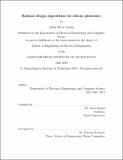| dc.contributor.advisor | Luca Daniel. | en_US |
| dc.contributor.author | Sadun, Allan Elvio. | en_US |
| dc.contributor.other | Massachusetts Institute of Technology. Department of Electrical Engineering and Computer Science. | en_US |
| dc.date.accessioned | 2019-12-05T18:06:06Z | |
| dc.date.available | 2019-12-05T18:06:06Z | |
| dc.date.copyright | 2019 | en_US |
| dc.date.issued | 2019 | en_US |
| dc.identifier.uri | https://hdl.handle.net/1721.1/123148 | |
| dc.description | This electronic version was submitted by the student author. The certified thesis is available in the Institute Archives and Special Collections. | en_US |
| dc.description | Thesis: M. Eng., Massachusetts Institute of Technology, Department of Electrical Engineering and Computer Science, 2019 | en_US |
| dc.description | Cataloged from student-submitted PDF version of thesis. | en_US |
| dc.description | Includes bibliographical references (pages 51-53). | en_US |
| dc.description.abstract | Recent developments in inverse design have demonstrated the power of computer algorithms for designing new and more efficient silicon photonic devices. However, most photonic design remains in human hands, because of the need to design for manufacturability and mitigate the impact of process variations, where computational tools and models have lagged behind. In this work, I investigate the viability and limitations of modeling and efficiently predicting the effects of one type of process variation, line edge roughness, using the adjoint simulation method. I then develop a robust optimization framework for designing devices that mitigate the impact of line edge roughness, using a hybrid worst-case / average-case scenario construction procedure, and demonstrate its application on the design of a Y-branch splitter. The resulting design experiences 20% less variation in the output imbalance between its two ports compared to the nominal design it started with, in addition to a decrease in insertion loss. Although the optimization algorithm suffers from overfitting as currently implemented, it remains a successful proof-of-concept and its framework is broadly applicable. | en_US |
| dc.description.statementofresponsibility | by Allan Elvio Sadun. | en_US |
| dc.format.extent | 53 pages | en_US |
| dc.language.iso | eng | en_US |
| dc.publisher | Massachusetts Institute of Technology | en_US |
| dc.rights | MIT theses are protected by copyright. They may be viewed, downloaded, or printed from this source but further reproduction or distribution in any format is prohibited without written permission. | en_US |
| dc.rights.uri | http://dspace.mit.edu/handle/1721.1/7582 | en_US |
| dc.subject | Electrical Engineering and Computer Science. | en_US |
| dc.title | Robust design algorithms for silicon photonics | en_US |
| dc.type | Thesis | en_US |
| dc.description.degree | M. Eng. | en_US |
| dc.contributor.department | Massachusetts Institute of Technology. Department of Electrical Engineering and Computer Science | en_US |
| dc.identifier.oclc | 1128830827 | en_US |
| dc.description.collection | M.Eng. Massachusetts Institute of Technology, Department of Electrical Engineering and Computer Science | en_US |
| dspace.imported | 2019-12-05T18:06:05Z | en_US |
| mit.thesis.degree | Master | en_US |
| mit.thesis.department | EECS | en_US |
